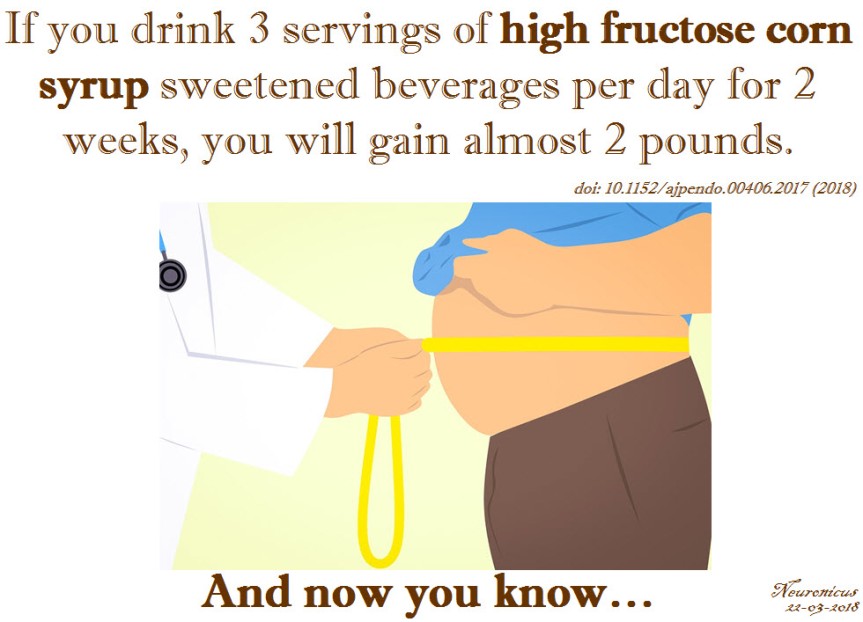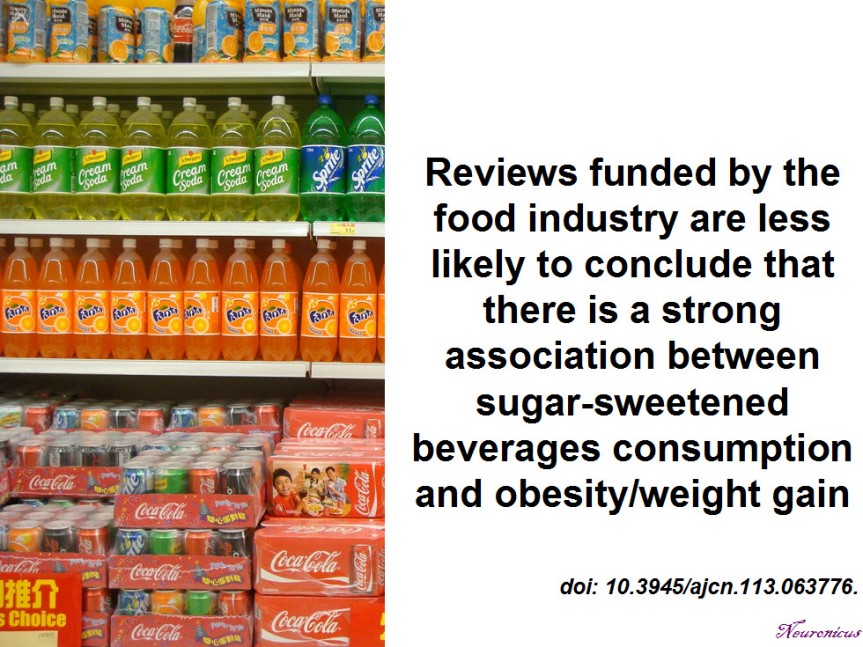Because I cannot leave controversial things well enough alone – at least not when I know there shouldn’t be any controversy – my ears caught up with my tongue yesterday when the latter sputtered: “There is strong evidence for eliminating sugar from commonly used food products like bread, cereal, cans, drinks, and so on, particularly against that awful high fructose corn syrup”. “Yeah? You “researched” that up, haven’t you? Google is your bosom friend, ain’t it?” was the swift reply. Well, if you get rid of the ultra-emphatic air-quotes flanking the word ‘researched’ and replace ‘Google’ with ‘Pubmed’, then, yes, I did researched it and yes, Pubmed is my bosom friend.
Initially, I wanted to just give you all a list with peer-reviewed papers that found causal and/or correlational links between high fructose corn syrup (HFCS) and weight gain, obesity, type 2 diabetes, cardiovascular disease, fatty liver disease, metabolic and endocrine anomalies and so on. But there are way too many of them; there are over 500 papers on the subject in Pubmed only. And most of them did find that HFCS does nasty stuff to you, look for yourselves here. Then I thought to feature a paper showing that HFCS is differently metabolized than the fructose from fruits, because I keep hearing that lie perpetrated by the sugar and corn industries that “sugar is sugar” (no, it’s not! Demonstrably so!), but I doubt my yesterday’s interlocutor would care about liver’s enzymatic activity and other chemical processes with lots of acronyms. So, finally, I decided to feature a straight forward, no-nonsense paper, published recently, done at a top tier university, with human subjects, so I won’t hear any squabbles.
Price et al. (2018) studied 49 healthy subjects aged age 18–40 yr, of normal and stable body weight, and free from confounding medications or drugs, whose physical activity and energy-balanced meals were closely monitored. During the study, the subjects’ food and drink intake as well as their timing were rigorously controlled. The researchers varied only the beverages between groups, in such a way that one group received a drink sweetened with HFCS-55 (55% fructose, 45% glucose, as the one used in commercially available drinks) with every controlled meal, whereas the other group received an identical drink in size (adjusted for their energy requirements in such a way that it provided the same 25% of it), but sweetened with aspartame. The study lasted two weeks. No other beverage was allowed, including fruit juice. Urine samples were collected daily and blood samples 4 times per day.
There was a body weight increase of 810 grams (1.8 lb) in subjects consuming HFCS-sweetened beverages for 2 weeks when compared with aspartame controls. The researches also found differences in the levels of a whole host of acronyms (ppTG, ApoCIII, ApoE, OEA, DHEA, DHG, if you must know) involved in a variety of nasty things, like obesity, fatty liver disease, atherosclerosis, cardiovascular disease, stroke, diabetes, even Alzheimer’s.
This study is the third part of a larger NIH-funded study which investigates the metabolic effects of consuming sugar-sweetened beverages in about 200 participants over 5 years, registered at clinicaltrials.gov as NCT01103921. The first part (Stanhope et al., 2009) reported that consuming fructose-sweetened, not glucose-sweetened, beverages increases visceral adiposity and lipids and decreases insulin sensitivity in overweight/obese humans” (title), and the second part (Stanhope et al., 2015) found that “consuming beverages containing 10%, 17.5%, or 25% of energy requirements from HFCS produced dose-dependent increases in circulating lipid/lipoprotein risk factors for cardiovascular disease and uric acid within 2 weeks” (Abstract). They also found a dose-dependant increase in body weight, but in those subjects the results were not statistically significant (p = 0.09) after correcting for multiple comparisons. But I’ll bet that if/when the authors will publish all the data in one paper at the end of clinical trials they will have more statistical power and the trend in weight gain more obvious, as in the present paper. Besides, it looks like there may be more than three parts to this study anyway.
The adverse effects of a high sugar diet, particularly in HFCS, are known to so many researchers in the field that they have been actually compiled in a name: the “American Lifestyle-Induced Obesity Syndrome model, which included consumption of a high-fructose corn syrup in amounts relevant to that consumed by some Americans” (Basaranoglu et al., 2013). It doesn’t refer only to increases in body weight, but also type 2 diabetes, cardiovascular disease, hypertriglyceridemia, fatty liver disease, atherosclerosis, gout, etc.
The truly sad part is that avoiding added sugars in diets in USA is impossible unless you do all – and I mean all – your cooking home, including canning, jamming, bread-making, condiment-making and so on, not just “Oh, I’ll cook some chicken or ham tonight” because in that case you end up using canned tomato sauce (which has added sugar), bread crumbs (which have added sugar), or ham (which has added sugar), salad dressing (which has sugar) and so on. Go on, check your kitchen and see how many ingredients have sugar in them, including any meat products short of raw meat. If you never read the backs of the bottles, cans, or packages, oh my, are you in for a big surprise if you live in USA…
There are lot more studies out there on the subject, as I said, of various levels of reading difficulty. This paper is not easy to read for someone outside the field, that’s for sure. But the main gist of it is in the abstract, for all to see.

P.S. 1. Please don’t get me wrong: I am not against sugar in desserts, let it be clear. Nobody makes a more mean sweetalicious chocolate cake or carbolicious blueberry muffin than me, as I have been reassured many times. But I am against sugar in everything. You know I haven’t found in any store, including high-end and really high-end stores a single box of cereal of any kind without sugar? Just for fun, I’d like to be a daredevil and try it once. But there ain’t. Not in USA, anyway. I did find them in EU though. But I cannot keep flying over the Atlantic in the already crammed at premium luggage space unsweetened corn flakes from Europe which are probably made locally, incidentally and ironically, with good old American corn.
P.S. 2 I am not so naive, blind, or zealous to overlook the studies that did not find any deleterious effects of HFCS consumption. Actually, I was on the fence about HFCS until about 10 years ago when the majority of papers (now overwhelming majority) was showing that HFCS consumption not only increases weight gain, but it can also lead to more serious problems like the ones mentioned above. Or the few papers that say all added sugar is bad, but HFCS doesn’t stand out from the other sugars when it comes to disease or weight gain. But, like with most scientific things, the majority has it its way and I bow to it democratically until the new paradigm shift. Besides, the exposés of Kearns et al. (2016a, b, 2017) showing in detail and with serious documentation how the sugar industry paid prominent researchers for the past 50 years to hide the deleterious effects of added sugar (including cancer!) further cemented my opinion about added sugar in foods, particularly HFCS.
References:
- Price CA, Argueta DA, Medici V, Bremer AA, Lee V, Nunez MV, Chen GX, Keim NL, Havel PJ, Stanhope KL, & DiPatrizio NV (1 Aug 2018, Epub 10 Apr 2018). Plasma fatty acid ethanolamides are associated with postprandial triglycerides, ApoCIII, and ApoE in humans consuming a high-fructose corn syrup-sweetened beverage. American Journal of Physiology. Endocrinology and Metabolism, 315(2): E141-E149. PMID: 29634315, PMCID: PMC6335011 [Available on 2019-08-01], DOI: 10.1152/ajpendo.00406.2017. ARTICLE | FREE FULTEXT PDF
- Stanhope KL1, Medici V2, Bremer AA2, Lee V2, Lam HD2, Nunez MV2, Chen GX2, Keim NL2, Havel PJ (Jun 2015, Epub 22 Apr 2015). A dose-response study of consuming high-fructose corn syrup-sweetened beverages on lipid/lipoprotein risk factors for cardiovascular disease in young adults. The American Journal of Clinical Nutrition, 101(6):1144-54. PMID: 25904601, PMCID: PMC4441807, DOI: 10.3945/ajcn.114.100461. ARTICLE | FREE FULTEXT PDF
- Stanhope KL1, Schwarz JM, Keim NL, Griffen SC, Bremer AA, Graham JL, Hatcher B, Cox CL, Dyachenko A, Zhang W, McGahan JP, Seibert A, Krauss RM, Chiu S, Schaefer EJ, Ai M, Otokozawa S, Nakajima K, Nakano T, Beysen C, Hellerstein MK, Berglund L, Havel PJ (May 2009, Epub 20 Apr 2009). Consuming fructose-sweetened, not glucose-sweetened, beverages increases visceral adiposity and lipids and decreases insulin sensitivity in overweight/obese humans. The Journal of Clinical Investigation,119(5):1322-34. PMID: 19381015, PMCID: PMC2673878, DOI:10.1172/JCI37385. ARTICLE | FREE FULTEXT PDF
(Very) Selected Bibliography:
Bocarsly ME, Powell ES, Avena NM, Hoebel BG. (Nov 2010, Epub 26 Feb 2010). High-fructose corn syrup causes characteristics of obesity in rats: increased body weight, body fat and triglyceride levels. Pharmacology, Biochemistry, and Behavior, 97(1):101-6. PMID: 20219526, PMCID: PMC3522469, DOI: 10.1016/j.pbb.2010.02.012. ARTICLE | FREE FULLTEXT PDF
Kearns CE, Apollonio D, Glantz SA (21 Nov 2017). Sugar industry sponsorship of germ-free rodent studies linking sucrose to hyperlipidemia and cancer: An historical analysis of internal documents. PLoS Biology, 15(11):e2003460. PMID: 29161267, PMCID: PMC5697802, DOI: 10.1371/journal.pbio.2003460. ARTICLE | FREE FULTEXT PDF
Kearns CE, Schmidt LA, Glantz SA (1 Nov 2016). Sugar Industry and Coronary Heart Disease Research: A Historical Analysis of Internal Industry Documents. JAMA Internal Medicine, 176(11):1680-1685. PMID: 27617709, PMCID: PMC5099084, DOI: 10.1001/jamainternmed.2016.5394. ARTICLE | FREE FULTEXT PDF
Mandrioli D, Kearns CE, Bero LA (8 Sep 2016). Relationship between Research Outcomes and Risk of Bias, Study Sponsorship, and Author Financial Conflicts of Interest in Reviews of the Effects of Artificially Sweetened Beverages on Weight Outcomes: A Systematic Review of Reviews. PLoS One, 11(9):e0162198.PMID: 27606602, PMCID: PMC5015869, DOI: 10.1371/journal.pone.0162198. ARTICLE | FREE FULTEXT PDF


